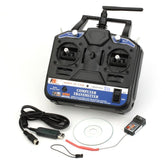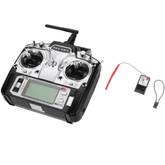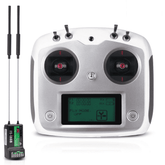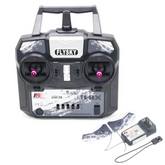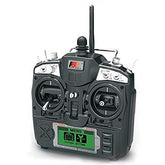Upgrade Your Control: Best Drone Remote Controllers
Summary
In this comprehensive blog, we delve into the world of drone remote controllers, offering everything you need to know to elevate your drone flying experience. We begin with an introduction, followed by an exploration of the fundamentals of drone remote controllers. Discover the top remote controllers on the market and gain insights on how to select the perfect one for your drone. Learn the step-by-step process of setting up and pairing your drone with your remote controller. Uncover advanced tips to master drone remote control, and ensure your equipment's longevity with maintenance and care guidelines. Join us on this journey, and take your drone piloting skills to new heights. Upgrade your control today!
Introduction
Modern technological advancements have enabled us to experience the thrill of controlling our own personal drone with the use of remote controllers. With these advanced tools, we are able to manipulate and navigate through aerial pathways in a whole new way! Thanks to their precise digital controls that enable smooth navigation as well as real-time adjustments such as zooming and tilting, they provide an efficient way for professionals alike to capture stunning visuals from high altitudes. Additionally, there is a variety of features available depending on your need; whether you're simply looking for recreational fun or capturing incredible footage professionally - drones provided by modern-day remotes can offer it all.
Choosing the right drone remote controller is essential to ensure smooth and safe operations. It’s important to be mindful of features such as wireless range, responsiveness, available channels, and integrated telemetry data when selecting one that best suits your needs. Wireless ranges should be considered in relation to size; larger drones require more robust connectivity between you and aircraft systems while smaller craft will need shorter transmission intervals for accurate control inputs. Responsiveness pertains not only to latency but also precision accuracy which can directly affect how accurately controlled motions are received by a drone. Channels refer specifically to how many pieces of user-defined information may transmitted at once - most typical professional applications utilise six or more on each side of communication linkages along with dedicated returns channeling feedback from the aircraft system back transmitter unit itself.
Visit our Drone Remotes collection page for best quality.
Understanding Drone Remote Controllers
In order to get the most out of your drone, it is important for you to understand the drone remote controllers. This type of controller allows you to customize and adjust your drone settings while in flight mode; allowing you greater control over its movements than ever before.
At first glance, a complex array of buttons may appear intimidating - however, with just some simple understanding, these features can be used confidently as part of an overall strategy when flying or racing your craft. With multiple channels available on each transmitter, users have the ability to assign values such as throttle speed or angle rates depending on their skill level and the goals they wish to achieve from their flights. In addition, this also includes being able to access pre-programmed functions such as automatic takeoff/landing or flip tricks during freefall which allow pilots further creative expression without needing additional programming knowledge given by expert software developers.
Furthermore modern transmitters often now offer transmission technology that provides lightning-fast response times helping provide precise manoeuvrability, ensuring seamless communication between pilot inputs received via radio frequency signal commands versus wired connections more commonly found within factory-ready models.
Ultimately taking time to research different brand model options will help ensure a better experience whether it’s purchasing entry-level items for perfect beginners who are new enthusiasts seeking ease of use compared to advanced range models designed to improve performance through tailored customization requirements experienced professional racers alike.
read more : Working of A Drone
Top Drone Remote Controllers
Fly Sky FS-CT6B 6ch 2.4GHz Transmitter and receiver

This Fly Sky FS-CT6B 6ch 2.4GHz Transmitter and receiver is the ideal choice for your radio control needs! This set includes a durable transmitter and receiver, providing superior signal quality while also being able to reach longer distances than traditional FM radios. The full range of function integration ensures maximum convenience with no need to upgrade any parts or accessories - ready out of the box! With its simple ergonomic design and intuitive user interface, you'll be controlling model aircraft like a pro in no time at all! Get superior stability and performance today.
read more : Drone Motor – Where to Begin?
FlySky FSI6 2.4GHz 6 Channel RC Transmitter

FlySky FSI6 2.4GHz 6 Channel RC Transmitter is a must-have for any serious radio control enthusiast. This advanced transmitter features an intuitive, easy-to-use interface with a large LCD display and plenty of customizable programming options so you can make every drive as smooth and precise as possible. With a range of up to 5km, the secure data transmission ensures that your signal stays clear from interference while providing reliable performance in all conditions - perfect whether you're flying cars or aircraft! The built-in ergonomic design fits comfortably in the hand making it comfortable enough for long flights without fatigue setting in quickly. Experience true professional grade quality when using FlySky FSI6 2.4GHz 6 Channel RC Transmitter today!
read more : Drone motor maintenance
FlySky FS-i4X 2.4GHz 4CH AFHDS R/C Transmitter with FS-A6 Receiver

The FlySky FS-i4X 2.4GHz 4CH AFHDS R/C Transmitter with FS-A6 Receiver is the ultimate in ease and convenience for multirotor, aeroplane, or helicopter flight control systems. This powerful unit features four channels of transmitted signal that provide reliable remote control performance from distances up to 800 meters away! The highly advanced 4in1 AFHDS2 S-FHSS protocol ensures secure signals between your receiver and transmitter with no interference or data loss. Included within this system are a host of cutting-edge features such as compatibility with distance measuring equipment (DME), configurable failsafe modes, and display screens via LCD backlight technology ensuring you have full command over every aspect of your flying session without ever having to take off your eyes from the skies; delivering an unparalleled experience!
read more : How to choose ESC for Quadcopter
FlySky FS-T6 6CH Transmitter with an FS-R6B Receiver

This FlySky FS-T6 6CH Transmitter with an FS-R6B Receiver is the perfect solution for RC enthusiasts looking to upgrade their experience. Featuring various ways to customize your model, this highly versatile system can be adapted in many different ways. It has a comfortable handle and easy access buttons so it's great for both novice pilots as well as professionals who want greater control over their hobby models. In addition, it has high-quality products that have been rigorously tested ensuring its reliability and performance standards are consistently met over time even while experimenting or testing new manoeuvres! Get maximum accuracy at all times without sacrificing any power or range – try out the FlySky today!
read more : Best flight controller for drone
Choosing the Right remote Controller for Your Drone
Are you looking for the right remote controller to operate your drone? With so many different options out there, it can be hard to decide which one is best. To help make this decision easier, here are some key factors that you should consider when choosing a remote control:
The first factor to look at is power output and range. The higher the power output of your radio transmitter - how far away from your drone will work - determines how much space you have available in which to fly safely. A wider range also allows greater manoeuvrability while flying with less risk of losing contact with the craft or signal to drop off completely due to an obstruction between them.
Next, check what type of measures their build comes equipped with antijamming capabilities and fail-safe procedures; these ensure uninterrupted operation even during interference from other sources such as another RC device nearby – stop accidental disconnects midflight if something goes wrong! Finally, take into account features like response rate (how fast commands get transmitted) dual sticks & gimbals orientation settings buttons etc. That all together makes up great overall performance plus operating convenience when piloting any quadcopter through its aerial manoeuvres without unnecessary hassle being involved in doing so.
read more : Choosing the right propellers for your Drone
How to Set Up and Pair Your Drone and remote Controller
Are you planning to fly a drone? Then, it's essential to understand the process of setting up and pairing your drone with its remote controller. we can help get you started! The setup may seem complicated but if followed correctly our step-by-step guide will make sure everything goes as smoothly as possible. Let's begin by gathering all necessary equipment: Drone, Remote Controller (transmitter), Batteries for both items and charger cables compatible with each battery type. It is important that these are connected properly so take care when doing this step! Once done proceed to power up the transmitter first then move on to switching on the device itself after ensuring antennas have been extended from both ends.
Now multiple lights should be visible – showing they’re ready for connection. To sync devices tap the ‘pairing' button located near the antenna--this ensures their frequencies align correctly enabling communication between them whilst also allowing navigation data exchange required during flight operation; Ensure the secure link remains intact by repeating steps whenever in doubt or experiencing difficulties operating either component i.e connecting power cable wrong way around doesn't support transmission etc,. Sticking to provided instructions one cannot fail to achieve a successful outcome plus greatly reduce the chances of issues arising later down the line due to safety precaution measures taken initially upon start & completion session thus making most out of dedicated flying experience ahead.
read more : Drone transmitter and receiver guide
Advanced Tips for Drone remote Control
Drone remote control can be quite a daunting task even for the most experienced hobbyists. But with some advanced tips, you too can become an expert in no time!
Start by familiarizing yourself with all aspects of your drone and its controller; make sure to read up on any related manuals or instructional videos so that you have a solid understanding of how everything works together. Next, practice flying safely while maintaining a visual line of sight - never fly beyond what is safe and legal. You should also get used to calibrating both the drone's motors as well as its compass correctly prior to each flight session taking off from different locations outside where interference might occur – resulting in better accuracy than just relying on GPS signals alone when airborne outdoors. Last but not least keep extra propellers handy since crashes do happen more often than one would like them to – If at any time things start going wrong act quickly by cutting power immediately this way props are less likely to break upon impact during landing especially indoors which could cause lesser damage overall. With these pro tips, you’ll feel empowered to handle Drone Remote Control responsibly, confidently, and efficiently every single time!
read more : Affordable drone batteries
Maintenance and Care of Your Drone Remote Controller
Maintaining and caring for your drone remote controller is essential to ensure it operates correctly, safely, and with optimal performance. Keeping your device clean should be the priority of any experienced user or newbie alike. The cleaning process should always begin by wiping away dust from the surface using a soft cloth - never use abrasive materials as this can cause scratches on its delicate exterior. After that's complete, take extra caution when handling all buttons so they don't get pressed during storage; if possible leave them open instead of closed until you need them again in order to prevent lint build up inside those crevices which could possibly damage internal components over time.
When not in use store the remotes separately from other items such as cell phones or laptops since these gadgets emit electromagnetic waves that can interfere with signals sent by some controllers. Batteries are also important – to maximize their life expectancy charge only once per flight session whenever feasible; removing batteries each time after flights makes them weaken faster than usual plus helps prevent corrosion due to heat generated over extended periods without being used at all (the bad news regarding corroded terminals that sometimes replacement isn’t an option). Lastly, check connections often before taking off with the aircraft to avoid potential frustration while enjoying that experience.
read more : How to build a quadcopter drone at home
Conclusion:
The world of drone flying is at your fingertips, and the right remote controller can make all the difference. We've taken you through the fundamentals of understanding drone remote controllers, introduced you to the top contenders in the market, and provided valuable insights on choosing the perfect match for your drone. Setting up and pairing your devices is now a breeze, and with advanced tips, you can take your skills to new heights. Don't forget the importance of maintenance and care for your remote controller to ensure its longevity. So, whether you're a novice or a seasoned pro, it's time to upgrade your control and elevate your drone flying experience. Get ready to soar, click that buy button, and let your drone adventures take flight!
If you appreciate our work don't forget to share this post and leave your opinion in the comment box.
Please do check out other blog posts about Popular electronics
Make sure you check out our wide range of products and collections (we offer some exciting deals!)



